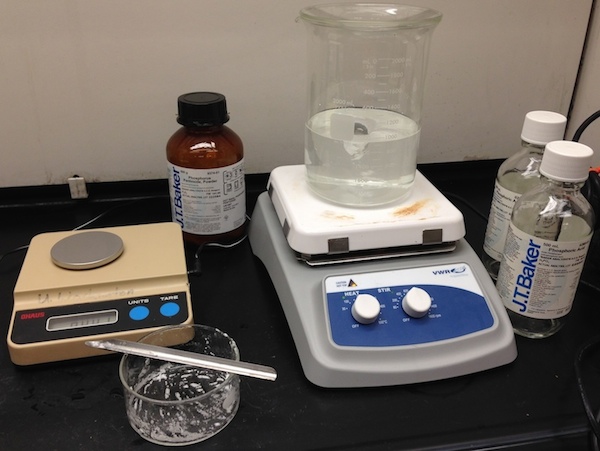Making 100% Phosphoric Acid
Introduction
Here we are going to make phosphoric acid to be used in carbonate digestions for isotopic analysis. The goal of this method is to produce phosphoric acid that has very little water and, as in our isotope geochemistry community, an agreed upon specific gravity. This particular recipe was obtained from the Eiler Lab and has the salient steps from original methods as in Coplen (1983). Differences from original methods are, we do not add chromium oxide or hydrogen peroxide. These were used to remove organics that may have originated from vacuum pump oil when acid was prepared by heating under vacuum. We also don't allow the acid to age. It's ready as soon as the specific gravity is appropriate.
Safety
Risks associated with this method include: phosphoric acid and hot surfaces.
Phosphoric acid is corrosive. Furthermore, you will be heating up the phosphoric acid to 80 °C. Don appropriate protective gloves when practicing this method.
Hot surfaces - You will be using a hot plate. Ensure you know where the hot surfaces are as you are working in the area.
This method is also a risk to others in the lab because it takes many hours and perhaps days to complete it. Make a sign and tape it to the fume hood sash so others are aware of the hot phosphoric acid's presence.
Supplies needed

- gloves
- Phosphorus pentoxide P2O5 (Corrosives Cabinet under fume hood in 302A)
- 85% ortho-phosphoric acid (Corrosives Cabinet under fume hood in 302A)
- stir bar
- stirring hot plate
- 2 L beaker
- low profile glass beaker
- spatula / scoupula
- watch glass
- manual glass thermometer (not digital thermometer)
- notepad / pen
- portable balance
- space in a hood
Routine Procedure
- Add 800 mL of acid to the 2 L beaker.
- Stir and heat to approximately 80 °C.
- Add 700 g P2O5 slowly until it all dissolves - this takes several hours. Try adding in 50 to 100 g at a time where you weigh out 100 g into the low profile pyrex beaker, slowly add it to the stirring acid using the spatula, wait until this 100 g fully dissolved before adding another round.
- You may wish to write down how much phosphorus pentoxide you add each time. The absolute amount is less important. What matters is the final specific gravity. It is very likely that you will add more than 700 g of P2O5.
- Take a known-volume sample of the acid, allow it to cool, measure its specific gravity. It should be between 1.90 and 1.92 g/mL.
- If the density is too high, add more acid, heat and stir; if the density is too low, add more P2O5, heat and stir.
- Pour the finished acid into cleaned and dried 85% ortho-phosphoric acid glass bottles.
- Label each bottle with your name, today's date, and the specific gravity.
Suggested Reading
- Coplen TB, Kendall C, Hopple J. 1983. Comparison of stable isotope reference samples. Nature 302, p 236 – 238.
- Purified phosphoric acid. Technical Information Bulletin. - This is a nice collection of phosphoric acid properties put together by Potash Corp.
